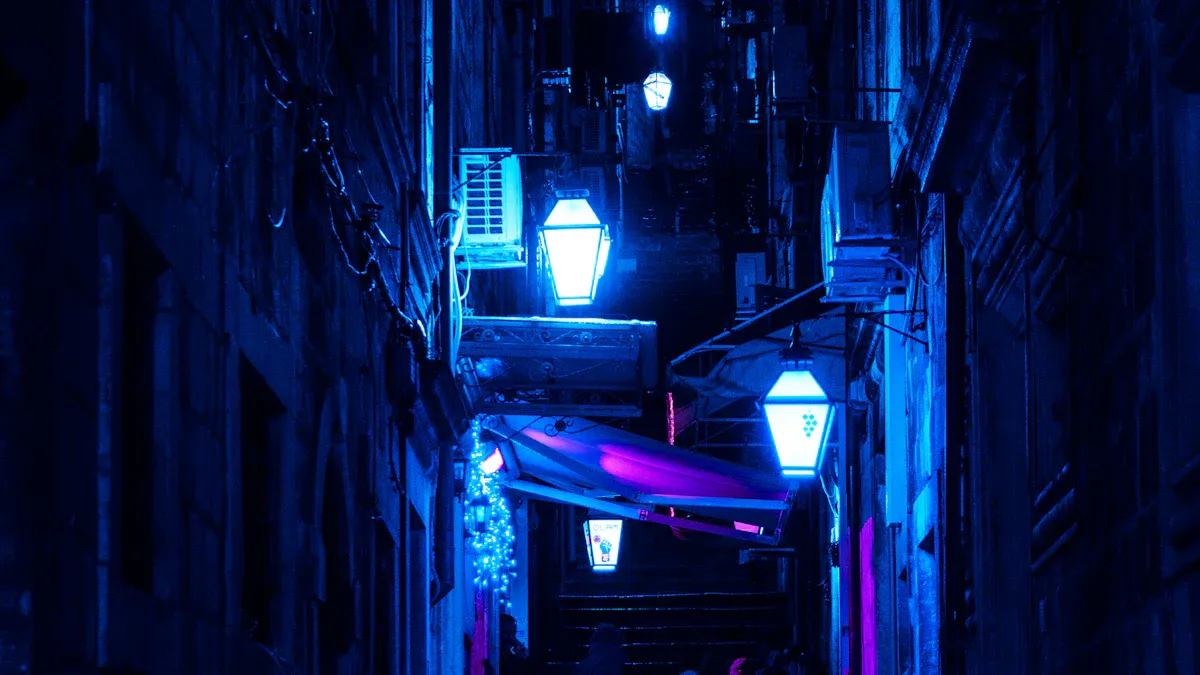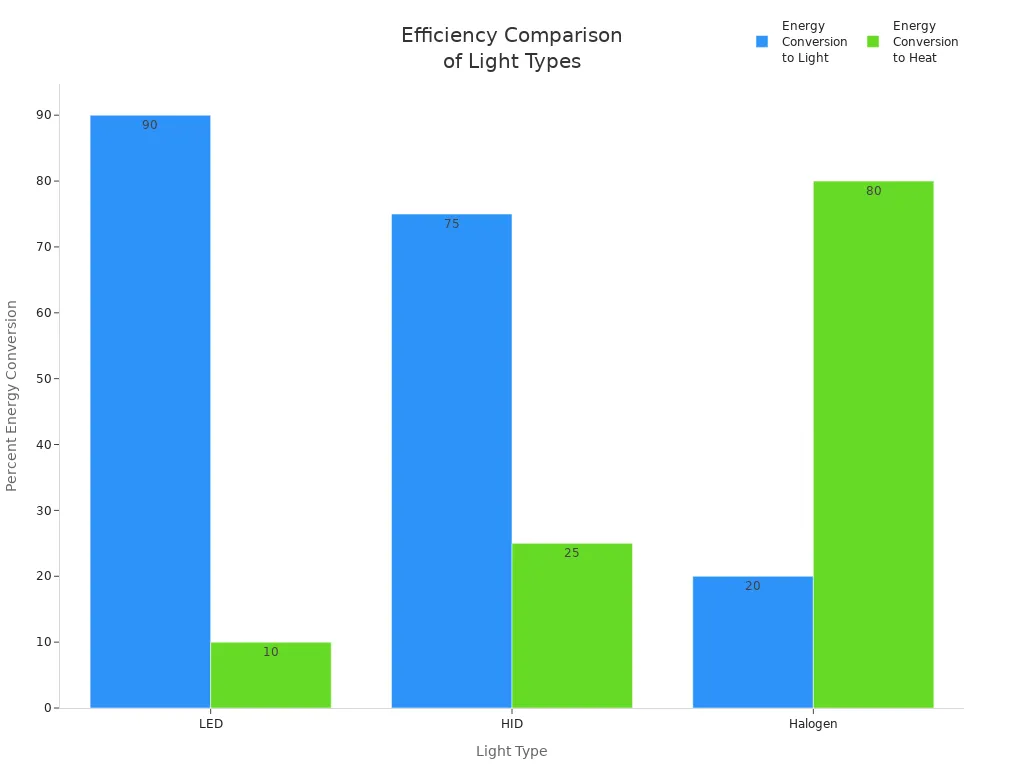HID Lights: Technology, Applications, and Benefits

HID Lights are widely used to illuminate various spaces, making them very bright. These lights enhance visibility when driving at night and are also beneficial for people working in large warehouses. Recently, HID Lights have gained popularity in cars, with the market projected to grow from USD 2.63 billion in 2021 to USD 3.52 billion by 2029.
The car lighting market was valued at USD 32,599 million in 2023 and is expected to reach USD 48,727 million by 2030.
If you are looking for lights for your home or want to learn more about our product offerings, HID Lights are easy to spot. They are efficient and have a long lifespan, making them a great choice for any setting.
About Us: We are dedicated to providing high-quality lighting solutions that meet your needs.
Key Takeaways
HID Lights give off strong light. They help people see better at night. They work well in big places like warehouses.
These lights save energy. They use less power than old bulbs. They shine brighter and can help lower your electric bill.
HID Lights last a long time. They can work for up to 24,000 hours. This means you do not need to change them often. You also spend less money on new lights.
There are different kinds of HID Lights. Each type works for a special job. Some are for cars, and some are for outdoor spaces. You can pick the one that fits your needs.
You should recycle HID Lights the right way. They have mercury inside. Recycling helps keep the earth safe. It also follows the rules for throwing them away.
HID Lights Overview

What Are HID Lights
HID Lights are used where bright light is needed. They use High-Intensity Discharge technology. These lights do not have a wire filament. Electricity goes through a gas to make light. This makes a strong and bright glow. You see HID Lights in car headlights. They are also in stadiums and big warehouses.
Fun fact: HID Lights take time to get bright. Other lights turn on right away.
Here is a table that shows how HID Lights are different from other lights:
Characteristic | HID Lights | Other Technologies (e.g., LED) |
|---|---|---|
Warm-up Time | Needs time to get bright | Turns on instantly |
Emissions | Gives off more IR and UV rays | Gives off fewer emissions |
Efficiency | Not as efficient as LEDs | Uses less energy |
Failure Characteristics | May flicker or turn off after long use | Works more steadily |
Some people think HID Lights are always brighter than LED lights. But new LED lights can be just as bright. They do not cause glare. Some say HID Lights cost less than LED lights. The first price is lower, but LED lights save more money later. They use less energy and last longer.
Types Of HID Lights
There are different types of HID Lights. Each type is used in different places. Here is a table that shows the main types and where you see them:
Type of HID Light | Applications |
|---|---|
Mercury Vapor | Used in gyms, factories, stores, banks, highways, parks, and sports fields. |
Metal Halide | Used in big halls, convention centers, and outdoor lighting. |
High-Pressure Sodium | Used for street lights, parking lots, and security lights. |
Low-Pressure Sodium | Used outside in special places, not as common. |
Mercury vapor lights are good for gyms and parks.
Metal halide lights are used in large halls and outside.
High-pressure sodium lights are for streets and parking lots.
Low-pressure sodium lights are used outside but not often.
You can pick the best HID Light for your needs. Choose based on where you want strong and steady light.
HID Lights Technology
How HID Lights Work
HID Lights make very bright light. They use ionization and electron excitation. When you turn on the light, electricity goes through xenon gas. This makes the gas ionized and forms an electric arc. Free electrons jump between energy levels. They give off energy as photons. You see this energy as bright light. HID Lights shine much brighter than regular bulbs.
Tip: HID Lights need time to get bright. Wait a few moments for full light.
Key Components
HID Lights have several important parts. Each part helps the light work well.
Here is a table that shows the main components and what they do:
Component | Role in Light Production |
|---|---|
Lamp | Main source of light, where the arc happens. |
Electronic Ballast | Controls voltage and current, keeps the lamp safe. |
Reflector | Directs and boosts light, helps spread it better. |
You can also check these key parts:
Arc Tube: Holds the gas for the electric arc.
Tungsten Electrodes: Work as contacts for the lamp base.
Outer Bulb: Made of strong glass, protects the arc tube and blocks UV rays.
The arc tube has the gas for the arc. Tungsten electrodes help start the arc. The outer bulb keeps the temperature steady. It protects the arc tube from harm. It also blocks harmful ultraviolet rays, so the light is safer.
HID Lights Applications

Automotive Use
You often see HID headlights in cars and trucks. These lights help you drive safely at night or in bad weather. HID headlights give you maximum brightness and performance. They can produce up to three times more light than standard halogen bulbs. The intense white light looks like daylight, so you see the road and signs more clearly. This reduces eye strain and helps you spot hazards faster. HID lights also use less energy, which can help your vehicle use fuel more efficiently.
Tip: HID headlights make night driving safer and more comfortable for you and other drivers.
Industrial And Commercial
Many factories, warehouses, and retail stores use HID lights. In the United States, about 80-90% of the 150 million lighting units in industrial facilities still depend on HID sources. You find these lights in high bay lighting, parking lots, and outdoor areas. HID lamps give bright and even light, which helps workers see better and stay safe. Good lighting also boosts productivity in busy spaces.
HID lights work well in:
Warehouses
Factories
Retail stores
Parking lots
Outdoor And Indoor Spaces
You can use HID lights in large indoor and outdoor spaces. These lights shine bright, white light and cover wide areas. Stadiums, sports fields, and warehouses often use them because they need strong illumination. HID lights give a high lumen output, so you get intense light for big spaces. They also use less electricity than older bulbs, which lowers your energy bills. HID lights can last up to 24,000 hours or more, so you do not need to replace them often.
HID lights are ideal for:
Sports stadiums
Large warehouses
Outdoor parking areas
Note: HID lights provide efficient, high-quality light for spaces that need bright and wide coverage.
HID Lights Benefits
Energy Efficiency
You want lights that save energy and money. HID Lights help you do this. They use less power than old bulbs. You get more light for each watt used. HID Lights can make 3,500 lumens with only 35 watts. Halogen bulbs need 55 watts for just 1,000 lumens. This means you use less electricity for the same or brighter light.
Light Type | Wattage | Lumens Output |
|---|---|---|
Halogen | 55W | 900-1,000 |
HID | 35W | 3,500 |
HID (high wattage) | 55W | 5,000 |
LED | Varies | 3,600 - 4,500 |
Choosing energy-saving lights helps the planet too. There are rules for HID ballasts to use less energy. These rules also help keep your workplace safe.
Note: Using energy-saving lights like HID Lights can lower your bills and help the earth.
Brightness And Longevity
You need lights that are bright and last long. HID Lights shine much brighter than halogen bulbs. You see strong, clear light in big spaces. This helps you work safely and see details better.
How long your lights last is important. You do not want to change bulbs all the time. HID Lights last much longer than halogen bulbs. Some HID lamps can work up to 24,000 hours. LEDs last even longer, but HID Lights give good brightness and lifespan.
Lighting Technology | Average Lifespan (hours) |
|---|---|
Halogen | 450 to 1,000 |
HID | 2,000 to 3,000 |
HID | 5,000 to 24,000 |
LED | 30,000 to 50,000 |
HID Lights last much longer than halogen bulbs. You spend less time and money changing them. This makes HID Lights a smart pick for busy places like warehouses and stadiums.
Tip: Pick lights that last longer to save money and time.
Color Rendering
You want lights that show colors well and clearly. HID Lights can have a color rendering index (CRI) of up to 60 when new. A higher CRI means colors look more real. This matters when you need to tell colors apart, like in stores or sports fields.
HID lights can reach CRI ratings of up to 60 when new.
The CRI rating goes down as HID lights get older.
Higher CRI ratings help you see colors better, which is important for jobs that need good color matching.
You may notice color quality changes as lights age. If you need the best color, check the CRI rating before buying. Good color helps you work better and keeps your space looking nice.
Callout: For jobs that need good color matching, always check the CRI rating of your lights.
You also need to think about the environment. HID Lights have mercury, so you must recycle them the right way. Many states say you must recycle or use special waste disposal for these lamps. Recycling helps get back useful materials and keeps bad stuff out of landfills.
Environmental Consideration | Details |
|---|---|
Presence of Mercury | HID lamps have mercury, which is bad for the environment. |
Disposal Regulations | Many states do not allow throwing away mercury lamps in landfills. You must recycle or use special disposal. |
Recycling Benefits | Recycling can get back mercury, copper, aluminum, and glass. This helps the environment. |
Note: Always recycle HID Lights to protect the earth and follow the rules.
HID Lights Vs. Other Lighting
HID Vs. LED
When you compare HID lights to LED lights, you notice some big differences. LED lights often shine brighter and last much longer. You will find that LED lights need less maintenance, which saves you time and effort. Here are some key points:
LED lights can be brighter than HID lights.
LED lights usually last three times longer.
You also get better energy savings with LED lights. Take a look at this table:
Light Type | Energy Conversion to Light | Energy Conversion to Heat |
|---|---|---|
LED | Up to 90% | 10% |
HID | 70-80% | 20-30% |
Halogen | 20% | 80% |

Tip: LED lights waste less energy as heat, so you get more light for your money.
HID Vs. Halogen
You may wonder how HID lights stack up against halogen bulbs. HID lights use a special arc of electricity, while halogen bulbs use a wire filament. HID lights shine much brighter and last longer. Halogen bulbs are easy to install, but they burn out faster and use more energy.
Feature | HID Lights | Halogen Lights |
|---|---|---|
Lifespan | 2,000 to 3,000 hours | 400 to 1,000 hours |
Energy Efficiency | More energy-efficient | Highest energy usage |
Brightness | Up to 3,000 lumens | Around 1,000 lumens |
HID lights can last up to 20,000 hours in some cases.
Halogen bulbs usually last less than 1,000 hours.
Note: HID lights give you more light and use less power than halogen bulbs.
HID Vs. Fluorescent
You might see both HID and fluorescent lights in big buildings. HID lights give off a very bright light, which works well for large spaces. Fluorescent lights use less energy and turn on instantly. They also spread light more evenly and stay cooler.
Feature | HID Lights | Fluorescent Lights |
|---|---|---|
Brightness | Very bright, good for large areas | Bright, even light |
Energy Consumption | Higher | Lower |
Lifespan | 6,000 to 24,000 hours | 7,000 to 15,000 hours |
Warm-up Time | Needs time to get bright | Instant |
Heat Emission | Higher | Lower |
HID lights have a higher color rendering index, so colors look more real. Both types contain mercury, so you must recycle them to protect the environment.
Callout: Always recycle your old lights to keep mercury out of landfills.
HID lights are very bright and last a long time. They also make colors look clear and real. You can find them in stadiums, factories, and outside areas. Look at the table below to see their main benefits:
Benefit | Description |
|---|---|
Energy Efficiency | Uses less energy than old bulbs |
Longevity | Lasts longer, saves on replacements |
Superior Color Rendering | Makes colors look clear and real |
Think about the fixture, cooling, and where you want to use them. HID lights are best for big, bright places and special uses like growing plants or lighting sports fields.
FAQ
What does HID stand for?
HID means High-Intensity Discharge. You see this term when you look at bright lights in cars, stadiums, or warehouses. HID lights use gas and electricity to make strong light.
How long do HID lights last?
You can expect HID lights to last from 2,000 to 24,000 hours. The exact time depends on the type and how you use them. You change them less often than halogen bulbs.
Are HID lights safe for the environment?
HID lights contain mercury. You must recycle them properly. Many states have rules for safe disposal. Recycling helps protect the earth and keeps harmful materials out of landfills.
Can you use HID lights at home?
You can use HID lights at home, but they work best in large spaces. You see better results in garages, workshops, or outdoor areas. HID lights may be too bright for small rooms.
Why do HID lights need a warm-up time?
HID lights need a few moments to reach full brightness. The gas inside the lamp must heat up and form an electric arc. You see the light get brighter as the process finishes.
See Also
Understanding LED Light Bulbs: Features, Advantages, and Choosing Tips
Exploring LED Area Lights: Uses, Advantages, and Setup Guidelines
LED High Bay Lighting: Uses, Benefits, and Choosing Factors
GE LED Bulbs: Characteristics, Advantages, and Choosing Guidelines
LED Street Lighting: Advantages, Technology Insights, and Benefits

